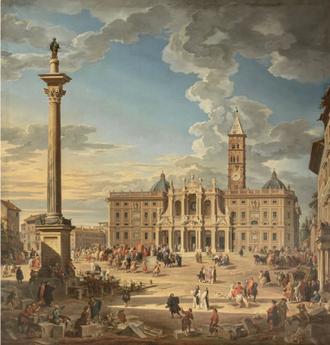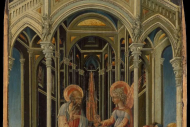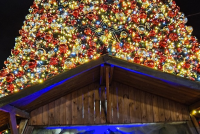Gospel in Art: The Dedication of the Basilica of Saint Mary Major

View of Piazza Santa Maria Maggiore, by Giovanni Paolo Panini © Quirinale Palace, Rome
Source: Christian Art
Gospel of 5 August 2024
Matthew 14:13-21
When Jesus received the news of John the Baptist's death he withdrew by boat to a lonely place where they could be by themselves. But the people heard of this and, leaving the towns, went after him on foot. So as he stepped ashore he saw a large crowd; and he took pity on them and healed their sick.
When evening came, the disciples went to him and said, 'This is a lonely place, and the time has slipped by; so send the people away, and they can go to the villages to buy themselves some food.' Jesus replied, 'There is no need for them to go: give them something to eat yourselves.' But they answered 'All we have with us is five loaves and two fish.' 'Bring them here to me' he said. He gave orders that the people were to sit down on the grass; then he took the five loaves and the two fish, raised his eyes to heaven and said the blessing. And breaking the loaves handed them to his disciples who gave them to the crowds. They all ate as much as they wanted, and they collected the scraps remaining; twelve baskets full. Those who ate numbered about five thousand men, to say nothing of women and children.
Reflection on the painting
The Dedication of the Basilica of Saint Mary Major is an optional memorial that the Church celebrates each year on the 5th of August. In the five years I have been writing these daily reflections, I haven't written about Santa Maria Maggiore before, so today is a good day to do so. In earlier editions of the General Roman Calendar, down to that of 1960, today's memorial is called the Dedication of the Basilica of St Mary of the Snows (In Dedicatione basilicae S. Mariae ad Nives), a reference to the legendary story about the foundation of the basilica. For the same reason the feast is also known popularly as Our Lady of the Snows.
The reference to the legend was removed in the 1969 revision of the General Roman Calendar. The 1911 Catholic Encyclopedia summarises ( Ott, Michael. "Our Lady of the Snow." The Catholic Encyclopedia. Vol. 11. New York: Robert Appleton Company, 1911): During the pontificate of Liberius (352 - 366AD), the Roman patrician John and his wife, who were without heirs, made a vow to donate their possessions to the Virgin Mary. They prayed that she might make known to them how they were to dispose of their property in her honour. On 5 August, at the height of the Roman summer, snow fell during the night on the summit of the Esquiline Hill. In obedience to a vision of the Virgin Mary that they had the same night, the couple built a basilica in honour of Mary on the very spot that was covered with snow. From the fact that no mention whatever is made of this alleged miracle until a few hundred years later, not even by Sixtus III in his eight-line dedicatory inscription ... it would seem that the legend has no historical basis." On 5 August each year, during the celebration of the liturgical feast of the Dedication of the Basilica of Saint Mary Major, a custom that commemorates the story of the miraculous snowfall, is still maintained: at the conclusion of Solemn Mass, a shower of white rose petals is dropped from the ceiling.
Our painting by Giovanni Paolo Panini depicts the Basilica of Saint Mary Major and the square in front of it. It is a charming scene painted in 1742. Giovanni Paolo Panini (1691-1765) was an Italian painter and architect known for his detailed and grandiose paintings of Roman architecture and urban scenes, rendered with exquisite detail. We can see how meticulous he was in his representation of the basilica's architecture. In the background we see a papal procession arriving. Elsewhere in the square are groups of secular faithful and religious, such as Franciscans and Dominicans.
The basilica was built in the 5th century under Pope Sixtus III (432-440). It was constructed to commemorate the declaration of Mary as Theotokos (Mother of God) by the Council of Ephesus in 431. This council affirmed Mary's role in the divine nature of Jesus Christ. As Pope Francis has a profound personal devotion to the Virgin Mary, he often goes to pray there, thus also encouraging the faithful to turn to Mary for guidance and support.
LINKS
Gospel in Art: https://christian.art/
Today's Reflection: https://christian.art/daily-gospel-reading/matthew-14-13-21-2024/


















